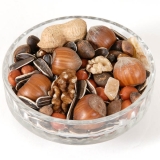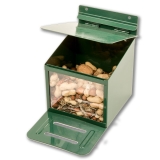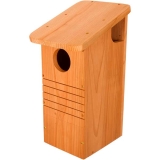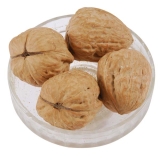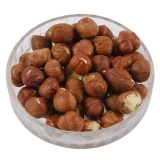Explore Our Garden Wildlife Blog
Browse or search by Category or Keyword below, alternatively click on any Tag to see related articles.


What Do Red Squirrels Eat & What To Feed Them in Your Garden
By Ark Wildlife
8th February 2021
Last Updated: 11th April 2024
The red squirrel is native to Britain but is now only found in limited areas of the UK. The population has been in a steep decline since the introduction of the North American grey squirrel. It is estimated that there are 20 grey squirrels for every red squirrel and this gap is sadly widening. Not many of us will be lucky enough to have red squirrels in our local area, let alone visiting our gardens, but if you are one of the lucky ones, here are a few tips on helping them.
Why should you feed red squirrels?
Pressures on the UK’s red squirrel population include loss of habitat (red squirrels are woodland dwellers), competition and disease (squirrel poxvirus) carried by the introduced grey squirrel. Facing this variety of threats and suffering from rapidly declining numbers, they will gladly take any food you can spare for them.


What do red squirrels eat?
Pine nuts make up a large part of red squirrels’ wild diet, but they also eat many seeds and other nuts, dependent on availability. Their diet also includes fungi, green shoots, dried fruits and berries. They can struggle to find food during the summer, when nuts, fruits and seeds aren’t ripe.
Although they will happily eat peanuts and they can form a healthy part of a red (or grey) squirrel’s diet, we should be careful not to overfeed squirrels with them. A handful or two for a family of squirrels is plenty. Any more and it can increase the risk of causing a serious calcium deficiency, due to the fact that peanuts have a low calcium to phosphorus ratio. Specialist, ready-made squirrel food, on the other hand, often comes coated with calcium.
Red squirrels, unlike other small mammals, do not hibernate and need to store enough food by ‘caching’, burying it underground and stashing it in tree crevices (sometimes referred to as a larder) in autumn to see them through the winter months. They will also eat copious amounts in the autumn, while food is plentiful, to put on weight before the onset of winter and this is important for breeding females, to maintain good condition for producing young in the spring.
Supplementary feeding of red squirrels has been shown to be beneficial, especially in times of shortages, and research also indicates they do not become dependent on hand-outs, which is important in case supplementary feeding stops. Before starting a routine of feeding, there are a few steps to follow to ensure best practice, always remembering to keep the health of the squirrels as your number one priority.


Red Squirrel Diet
Red squirrels are naturally woodland dwelling seed eaters. Deciduous woodland offers greater opportunity for foraging but populations are now often restricted to coniferous forests.


What to feed red squirrels
Food you can provide for Red Squirrels include:
Whole Hazelnuts in Shells
Pine Nuts
Walnut Kernels
Walnut in Shells
Ark Red Squirrel Food
Striped Sunflower Seeds and Peanuts (These are low in calcium and excess feeding can result in calcium deficiency)
Proprietary Red Squirrel Food is an excellent option because it has been developed specifically for the red squirrels dietary requirements and contains added soluble calcium to maintain health, especially for pregnant females.


Other foods that can be provided in smaller quantities include:
Banana chips
Carrots
Apples
Dried fruit
Other native fruit, vegetables and nuts
(Only ever use raw, unsalted food)
It is best to offer squirrel food on a little and often basis to ensure the squirrels continue to forage naturally and you can increase generosity in the autumn to help them gain weight in time for winter and build a cache.


How to feed red squirrels
The easiest way to feed red squirrels is with ready-made, nutritious squirrel food (coated in calcium), using a special squirrel feeder. Place the feeder high up in a tree, to keep feeding squirrels protected from predators like cats. And be careful not to feed them if grey squirrels are around, to keep the two species separated.
If they come into contact with each other, greys can pass squirrelpox onto red squirrels. While this disease doesn’t usually kill grey squirrels, it normally proves fatal in their red cousins.
Considerations when feeding red squirrels
With a little care, we can provide a safe and reliable source of food for the supplementary feeding of red squirrels, to add to their wild diet. However, there are a number of unintended hazards to be considered first. Here’s our top tips of dos and don’ts to help you navigate the pitfalls.
Don’t: Encourage red squirrels to cross roads. Do: Feed them on their side of the street
Don’t Feed them if there are grey squirrels present Do: Invest in a special squirrel feeder
Don’t: Risk accidental drowning Do: Cover water butts etc. and provide a shallow-sided water bowl
Don’t: Feed where there are cats Do: Feed high in trees where squirrels can hide from all predators
Don’t: Feed high quantities of peanuts or fruit Do: Provide calcium supplements like Cali-Dust and Cuttlefish


Above all enjoy your red squirrels; you’re one of the lucky few. Get in contact with your local Wildlife Trust or Red Squirrel Conservation Group and support them by donating financially or with your time and learn all you can to this struggling species.
Related Internet Links:
Saving Scotlands Red Squirrels
Red Squirrels of Northern England
Anglesey Red Squirrels
Ark Wildlife is not responsible for the content of external websites






